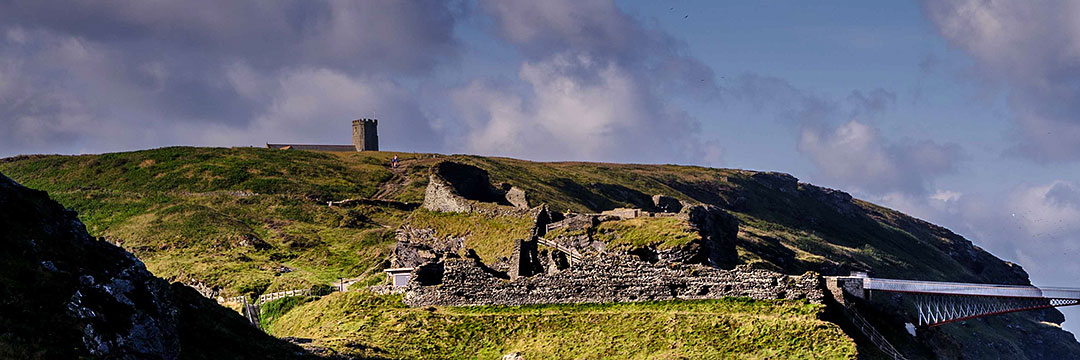Description of Tintagel Castle
The site at Tintagel is dominated by its natural topography, particularly the eroded neck of land dividing the island from the mainland. The castle lies on both sides of the chasm. Centuries of erosion have taken many parts of the castle and earlier buildings with them.

The Mainland
The mainland section of the castle is in two parts, the lower and upper wards. The lower ward is the courtyard forming the entrance to the whole castle, and enclosed on the south-east and north-east sides by a curtain wall.
On top of the crag is the upper ward, with a further curtain wall and various small buildings belonging to the medieval castle; imported pottery from the 5th or 6th century has been found here. At this end of the courtyard is the medieval gateway forming the entrance to the castle. Outside that is the great ditch, which dates from the 5th–7th centuries, and made the headland into a promontory fort.
Further inland and uphill, several more banks and mounds are visible. They do not seem to have been investigated closely, and their date is not known.
The Island
The inner ward, on the island, contained the castle’s Great Hall, built on a sheltered, man-made terrace. By 1337, only a century after being built, the hall was in decay, and a few years later it was rebuilt by Edward the Black Prince as smaller buildings on the same site. This area was also a main focus of the 5th–7th-century occupation, where large quantities of Mediterranean pottery have been found, although any remains from that period are now buried underneath the medieval castle.
Much of the level surface of the island is covered by lines of small rectangular huts. Some are visible today, having been reconstructed after excavation in the 1930s; but many more became known only when a fire swept the headland during the dry summer of 1983.
For the most part the huts were flimsily built, as if for temporary occupation. Their rectangular shape is unusual for Cornwall in the 5th to 7th centuries, but excavation has confirmed that these buildings belong with the 5th- or 6th-century pottery found among them.[1] Below the northern end of the inner ward is the Iron Gate, a protective wall guarding a slate platform which forms the only landing-spot on the island.
Among the group of buildings at the northern end of the island are some more substantial structures, including one that contains a circular corn-drying kiln, similar to those found at the 13th- or 14th-century village of Houndtor on Dartmoor. This building may belong to the same period. If so, it was a small-scale farm growing grain crops at about the time when the castle was built, but was preceded by buildings of the earlier settlement.
The main focus of activity on the summit of the island is the area around the chapel. The chapel is dedicated to St Juliot, presumably a local saint, and is of uncertain date. The main body of what now exists is contemporary with the castle. The location here, rather than with the main castle buildings, and the presence of several rock-cut graves in the vicinity,[2] suggest reuse of an older site.
Around the chapel are buildings of various dates, some overlying others and interconnecting, suggesting a complex sequence of uses.
Footnotes
1. RC Barrowman, CE Batey and CD Morris, Excavations at Tintagel Castle, Cornwall, 1990–1999, Reports of the Research Committee of the Society of Antiquaries of London, 74 (London, 2007).
2. One at the north-east corner of the chapel was noted by Leland in about 1540 and by Norden in about 1600. It was still visible in the 1980s, but has since been filled in.
Find out more about the castle
-

History of Tintagel
Read an in-depth history of the castle from its origins in the Roman period to the present day, and find out why Tintagel’s history and legends are so intertwined.
-

Richard of Cornwall and Tintagel Castle
Discover why the legend of King Arthur led one of the richest men in 13th-century England to build a castle at Tintagel.
-

Why does Tintagel matter?
Discover Tintagel’s importance in the 5th to 7th centuries, how this inspired its literary fame, and how this in turn led to the building of the medieval castle.
-

Research on Tintagel Castle
Find out how archaeology has transformed our understanding of Tintagel over the last century, and what remains to be discovered by further research.
-

Sources for Tintagel Castle
Use this list of visual and written sources, published and unpublished, to learn more about Tintagel Castle and its history.
-

Tintagel Castle Collection
Explore in detail ten key objects found at Tintagel and find out what they tell us about the castle and earlier settlement.
-

Download a Plan
Download this PDF plan of Tintagel to explore the castle and see how it has developed over time.
-

More histories
Delve into our history pages to discover more about our sites, how they have changed over time, and who made them what they are today.